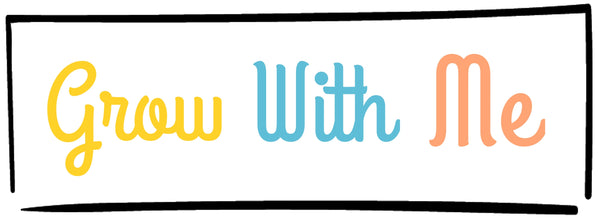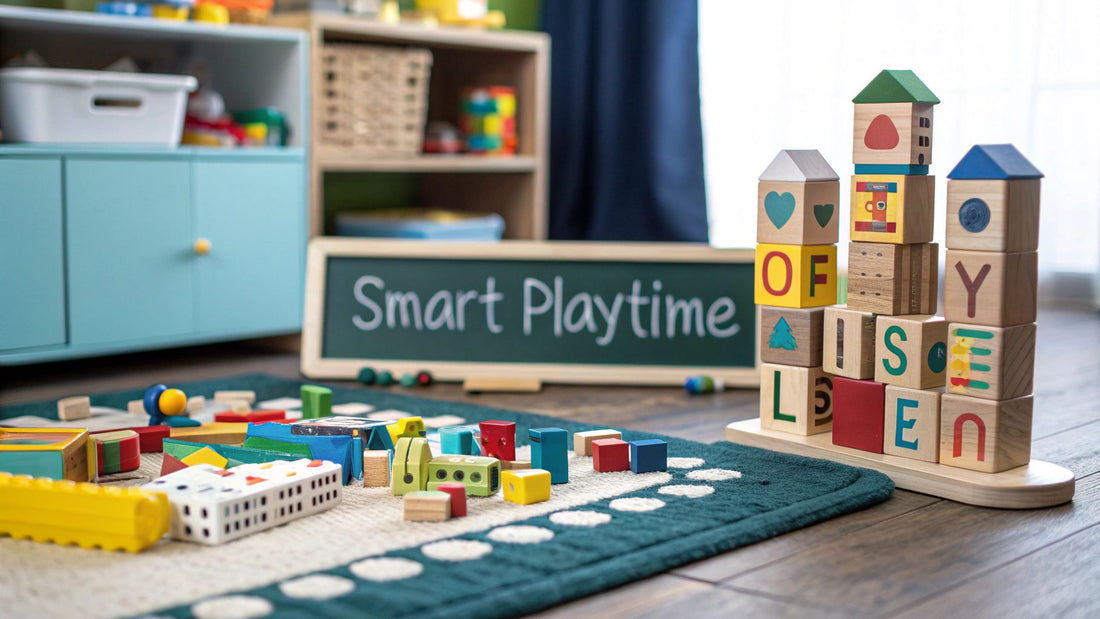
Best Educational Toys for 18 Month Olds
Share
When you're looking for the best educational toys for an 18-month-old, think about things that support their incredible developmental explosion. You can't go wrong with classics like stacking blocks, chunky puzzles, and shape sorters. These simple, hands-on toys are brilliant because they tap right into a toddler's budding curiosity and physical skills, building a solid foundation for fine motor control and problem-solving.
What Your 18-Month-Old Is Learning Through Play
At 18 months, your toddler's world is a constant whirlwind of discovery. They've moved on from being passive babies to becoming active little scientists, figuring out how everything works one block, or one dropped spoon, at a time. It’s a period of massive cognitive and physical leaps, making it the perfect time to introduce toys that truly challenge and delight them.
Understanding their developmental milestones gives you a powerful lens for choosing the right toys. It helps you see beyond the bright colours and flashy lights to find items that genuinely support their growth.
The Cognitive Leap Forward
Your toddler's brain is firing on all cylinders, constantly making new connections. You’ll see this in how they approach simple problems. That moment they finally slot a square shape into the matching hole? That's a huge cognitive win. They're learning about cause and effect, spatial awareness, and the fact that things still exist even when they can't see them.
This is also the age when symbolic thinking starts to bubble up. A banana might suddenly become a telephone, or they might try to feed their favourite teddy a snack from an empty plate. This early imaginative play is the very foundation of creative thinking.
At this stage, play isn't just about fun; it’s how toddlers process the world and test their theories. Every toy becomes a tool for a new experiment.
Mastering Movement and Motor Skills
Physically, your little one is making huge strides. Just managing to stack two or three blocks is a massive achievement, showcasing their developing fine motor skills and hand-eye coordination. These are the small, precise movements that will one day help them hold a crayon or use a fork.
At the same time, their larger movements are becoming more confident. They're likely walking with purpose, maybe even attempting a clumsy run or clambering onto the sofa. Toys that encourage movement are essential for building strength, balance, and coordination. In the UK, educational toys for 18-month-olds are well-regarded for helping with physical dexterity and sensory stimulation. Simple activity toys like balls and beanbags are perfect for honing these core motor skills.
Language and Social Skills in Bloom
You've probably noticed that your 18-month-old's communication is exploding. While they might only have a handful of actual words, they understand so much more than they can say. When you ask, "Where is the kitty?" and they point to the picture in a book, that’s their receptive language growing right before your eyes.
This stage also marks the beginning of "parallel play," where they play alongside other children rather than directly with them. Toys that can be easily shared, like a big set of blocks, gently introduce the first concepts of social interaction. It’s also a fantastic age to bring in different textures and materials. For more inspiration, have a look at our guide on sensory play ideas for toddlers.
Choosing Toys That Nurture Specific Skills
Now that you have a better picture of your toddler’s world, you can start matching toys to their specific developmental milestones. It’s not about hunting for one single "perfect" toy. Instead, think about building a small, thoughtful collection that supports key growth areas and meets them right where they are on their journey.
Different toys serve different purposes, and that’s a good thing. Chunky puzzles and shape sorters are fantastic for boosting those budding cognitive skills, teaching them the basics of problem-solving and how things fit together. At the same time, a simple push-along walker or a set of big, lightweight blocks can do wonders for their gross motor strength and coordination.
Boosting Cognitive and Fine Motor Skills
Just stop and think about the incredible work that goes into your toddler picking up a chunky puzzle piece. They’re strengthening the pincer grip and honing the hand-eye coordination they’ll one day use to hold a pencil and write their name. This is exactly why simple, hands-on toys are so powerful at this age.
You don't just have to take my word for it. A detailed UK study, backed by international research involving 243 children, found that 18-month-olds were far more engaged with exploratory and interactive toys that matched their developmental stage. The study specifically called out shape sorters and simple puzzles as being brilliant for encouraging positive behaviour and learning.
The image below gives a great visual breakdown of how different types of toys can really move the needle in key developmental areas.
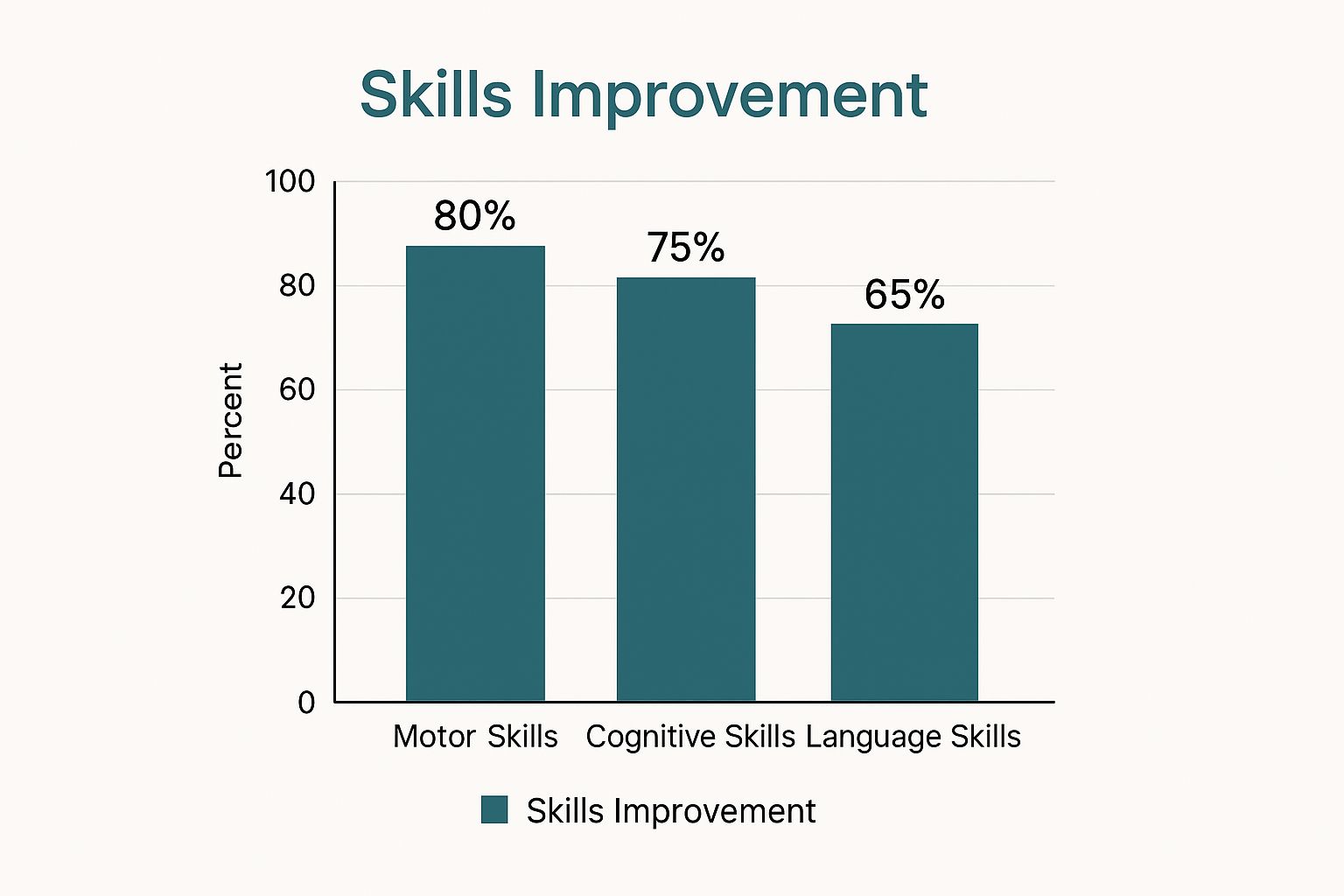
As you can see, targeted play makes a huge difference, with motor skills often seeing the biggest leap forward from interactive toys.
Encouraging Physical and Language Development
It’s not all about puzzles and stacking rings, though. The right toys are also crucial for getting your toddler moving and talking. The trick is to look at a toy and ask yourself, "How will this encourage my child to move their body or use their words?"
Take a simple ball, for instance. It invites so many actions! Your toddler might push it, try to throw it, or toddle after it as it rolls away. This back-and-forth game also creates the perfect, natural opportunity for language to blossom. Simple words like "ball," "roll," "go," and "my turn" suddenly have a fun, physical context.
Let’s get a bit more specific. Here's a quick guide to matching developmental milestones with the right kinds of toys.
How to Match Toys to Your Toddler's Development
This table is a handy reference for connecting what your 18-month-old is learning to do with toys that can help them master those skills.
| Developmental Area | Key Milestone at 18 Months | Recommended Toy Types | Example Toy |
|---|---|---|---|
| Cognitive | Begins to solve simple problems through trial and error. | Puzzles, shape sorters, ring stackers. | A wooden puzzle with 2-4 large, chunky pieces and knob handles. |
| Fine Motor | Uses pincer grasp to pick up small objects. | Blocks, large threading beads, chunky crayons. | A set of large, interlocking plastic blocks. |
| Gross Motor | Walks independently; may start to run. | Push/pull toys, ride-on toys, soft balls. | A classic wooden duck pull-along toy. |
| Language | Says several single words; points to objects when named. | Picture books, animal figurines, toy telephones. | A sturdy board book with bright pictures of familiar objects. |
Think of this as a starting point. The goal is to provide a balanced "play diet" that nourishes all areas of their development.
By choosing toys with a clear purpose in mind, you create a play environment that isn't just fun, but is perfectly tuned to support their amazing journey of discovery. If you'd like to dive deeper, our guide on developmental toys for toddlers has even more great insights. This way, you can feel confident that every playtime is a chance for meaningful learning.
A Parent's Guide to Toy Safety and Quality
A fun toy is only a great toy if it’s a safe one. It’s easy to get swept up in the bright colours and promises of educational benefits, but your first job is to be the safety inspector. Think of this as your practical, hands-on checklist for vetting any toy before it makes its way into your home.
This way, you can be completely confident that your child’s play space is both enriching and secure.
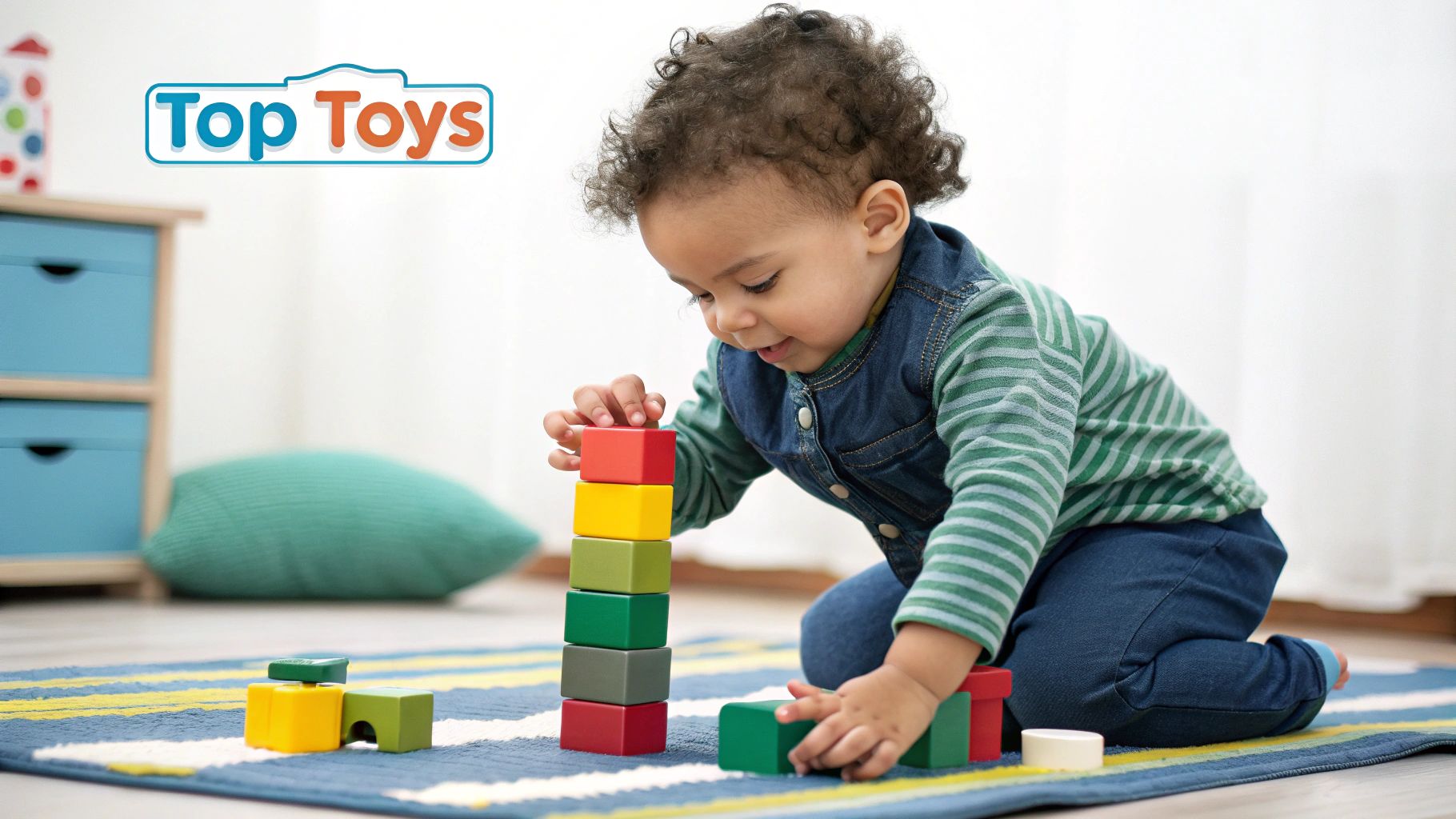
Let’s go beyond the obvious and get into the tangible things you should be looking for, whether you're buying something brand new or picking up a pre-loved gem.
Decoding Safety Labels and Materials
The first thing to look for on any new toy is the UKCA mark (you might still see the older CE mark on some products). This isn’t just a random sticker; it's the manufacturer's promise that the toy meets the UK's incredibly strict safety standards. It’s your green light, confirming it’s been properly assessed for things like flammability and chemical nasties.
But don't stop there. Get your hands on it. At 18 months, absolutely everything ends up in the mouth, so non-toxic materials are a must. Look for solid wood finished with water-based paints, food-grade silicone, or sturdy, BPA-free plastics. This info should be easy to find on the packaging or in the online product description.
Remember, a safety mark guarantees compliance, but your hands-on inspection is what confirms real-world durability. A toy that feels flimsy or has a strong chemical smell is a red flag, regardless of its certification.
The Choking Hazard Check
For this age group, choking is the biggest risk. You can do a quick, surprisingly effective check at home with something you already have: a toilet paper roll. If a toy, or any part of it that could break off, can fit completely inside the tube, it’s a potential choking hazard. It's that simple.
This little trick is especially crucial for:
- Second-hand toys where bits and pieces may have loosened over the years.
- Toys with small components, like the wheels on a toy car or the button eyes on a teddy.
- Battery compartments, which must be secured with a screw to keep curious fingers out.
Give every part a good, firm tug. If anything feels wobbly or like it could be pulled off by a determined toddler, it’s a no-go.
Built to Last Through Toddler Play
Finally, just look at how the toy is made. Toddlers aren't exactly known for their gentle touch, so durability isn't just about value for money—it's a critical safety feature. A well-built toy won't splinter into sharp shards or break into small, dangerous pieces during a bout of enthusiastic play.
Run your hands over the surface. You want smooth, rounded edges to avoid scrapes and bumps. On plastic toys, check that the seams are properly sealed with no sharp bits. For wooden toys, make sure they are completely splinter-free. A toy built for an 18-month-old should be able to withstand being dropped, thrown, and yes, even chewed on, without falling apart. This commitment to quality is what makes the best educational toys for your 18 month old also the safest.
The Power of Open-Ended and Close-Ended Play
Ever noticed how some toys hold your toddler's attention for months, while others are tossed aside after a week? The secret often lies in having a balanced 'play diet'. Just like we need a mix of foods to be healthy, little ones thrive when they have different kinds of play. This is where understanding the difference between open-ended and close-ended toys can make a huge difference.
These two approaches to play might sound technical, but the idea is simple. Each one nurtures a different, but equally vital, set of skills. By making sure your 18-month-old has access to both, you’re creating a really rich environment that supports their development from every angle.
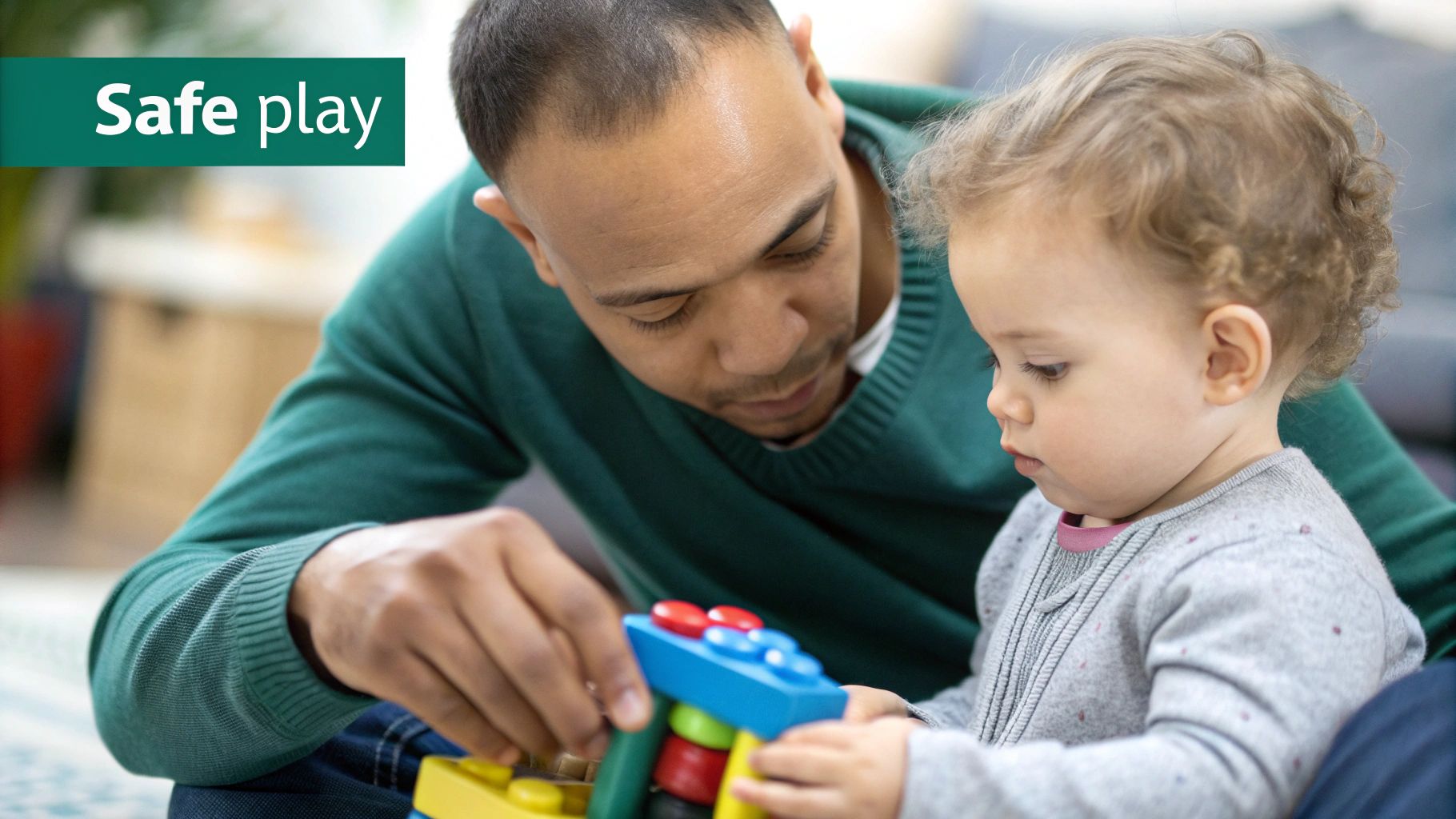
Unlocking Creativity with Open-Ended Toys
Open-ended toys are the true champions of imagination. Think of them as the toys without an instruction manual or a single "right" way to be used. Classic wooden blocks, a tub of animal figurines, or even a simple box of play silks are perfect examples. The possibilities are truly endless.
One day, those blocks build a towering skyscraper; the next, they become a fence for farm animals. This kind of play is so powerful because it puts your child in the director's chair. They're the ones inventing the rules and creating the stories, which is fantastic for boosting creativity, independent thought, and problem-solving.
Many of the best educational toys for an 18-month-old fall into this category precisely because they grow with your child. The way they play with stacking rings at 18 months is completely different from how they might use them in pretend play at age three, making these toys a brilliant long-term investment.
Building Focus with Close-Ended Toys
On the other side of the toy box, we have close-ended toys. These are items with a specific goal or a clear solution. A shape sorter has one correct hole for each shape, and a puzzle only fits together one way.
While that might sound a bit restrictive, this focused play is incredibly valuable for a developing mind. Close-ended toys are fantastic for teaching:
- Logical reasoning: Figuring out which piece goes where builds foundational problem-solving skills.
- Persistence: They encourage your toddler to keep trying until they get it right.
- Task completion: There’s a real sense of achievement when they finally fit that last puzzle piece in!
This structured play is brilliant for developing concentration and an understanding of cause and effect. It’s the perfect partner to the free-flowing creativity of open-ended toys. For those who love toys that combine structure with natural materials, exploring Montessori toys for toddlers can offer some wonderful ideas.
To make it even clearer, let's break down how these two types of toys compare and what unique benefits they bring to your child's playtime.
Open-Ended vs. Close-Ended Toys at a Glance
| Toy Type | Primary Goal | Skills Developed | Example |
|---|---|---|---|
| Open-Ended | Process-oriented; exploration and creativity | Imagination, problem-solving, storytelling, independence | Building blocks, play-doh, art supplies, animal figurines |
| Close-Ended | Goal-oriented; finding a specific solution | Logic, fine motor skills, persistence, task completion | Puzzles, shape sorters, bead mazes, nesting dolls |
Ultimately, a well-rounded toy collection includes a healthy mix of both. They aren't in competition; they're a team, working together to build a strong developmental foundation.
The real magic happens when you see them blend. A child might spend ten minutes intently focused on a puzzle (close-ended), then flip the pieces over and use them as "biscuits" for their teddies (open-ended). This seamless switch is what nurtures a resilient, creative, and adaptable little learner.
Our Top Educational Toy Recommendations
It's one thing to talk about developmental play in theory, but seeing it in action makes choosing the right toys so much easier. Let's move from the abstract ideas to some concrete examples.
Think of this less as a shopping list and more as a series of case studies. The goal is to train your eye, so you can walk into any toy shop and feel confident you’re picking a winner. We’ll look at some classic favourites and a few modern innovations, breaking down exactly what makes them some of the best educational toys for an 18-month-old.
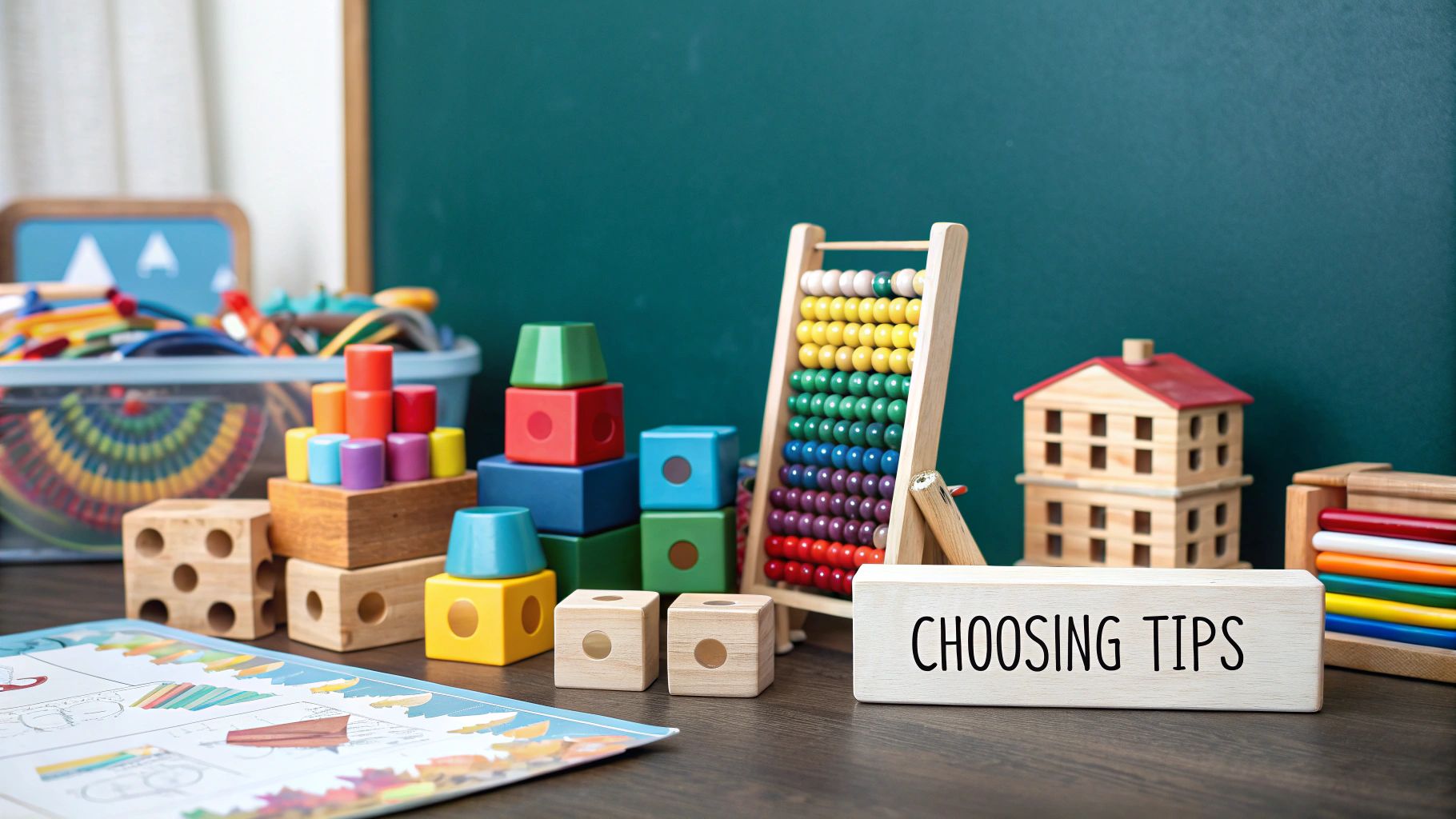
Classics That Stand the Test of Time
Some toys are classics for a very good reason—they just work. Their magic often lies in their simplicity, offering endless ways to learn without overwhelming a curious little mind.
Take a set of chunky wooden puzzles with big knob handles. Grasping that knob is a fantastic workout for their pincer grip, which is the exact same skill they'll need for holding a pencil in a few years. As they work to fit a piece into its slot, they're actively figuring out spatial awareness and solving a mini-problem all on their own.
In the same way, a simple ring stacker is a developmental powerhouse. At first, your little one will probably just have a blast taking all the rings off. But soon, they’ll start trying to put them back on, honing their hand-eye coordination with every single attempt. It’s a simple toy that teaches complex ideas like size, order, and cause-and-effect in the most natural way possible.
The best toys often don't do much on their own. Instead, they invite your child to do something with them, placing your toddler in the driver's seat of their own discovery.
Modern Toys with a Developmental Focus
While the classics are brilliant, some modern toys are cleverly designed to offer unique, multi-faceted learning experiences. They often combine several types of play into one engaging toy.
For instance, activity tables like the Fisher-Price Laugh & Learn 4-in-1 Activity Table & Easel, which usually costs around £50-£60, are often praised by UK testers for how they encourage strength, balance, and creativity all at once. There are also brilliant modular toys like the Fat Brain Toys PlayTab Essentials, which use magnetic tiles to stimulate problem-solving and sensory skills in a way that really holds an 18-month-old’s attention.
These are great examples of how smart design can support different developmental areas at the same time. You can find more inspiration in reviews from trusted sources, like this Good Housekeeping guide to toys for one-year-olds.
Why These Toys Work for an 18-Month-Old
So, what's the common thread here? Why do these particular toys hit the mark for this age group? The best ones masterfully blend a physical challenge with a cognitive one.
- They match physical abilities: The pieces are large enough for clumsy little hands to grasp, but still require enough fine motor skill to feel like a satisfying achievement.
- They build cognitive skills: Every toy has a clear goal—fit the puzzle piece, stack the rings, post the shape. This encourages focus and the beginnings of logical thinking.
- They are often open-ended: A set of blocks isn't just for building a tower; it can be a fence for toy animals, a car, or anything else they can dream up. This flexibility fuels imagination and keeps the toy interesting for months, or even years.
When you start focusing on these core elements, you move beyond just buying toys and begin building a truly valuable collection of learning tools. This mindset empowers you to spot the educational potential in almost anything, turning every playtime into an opportunity for real growth.
Common Questions from Parents
https://www.youtube.com/embed/rAZm1zmnLhs
Choosing the right toys often feels like navigating a maze. It’s completely normal to have questions and wonder if you're making the best choices. Let's tackle some of the most common concerns I hear from parents, giving you clear, practical answers so you can feel confident about playtime.
My goal here is to help you create a play environment that truly nurtures your toddler's incredible curiosity.
How Many Toys Does My 18-Month-Old Really Need?
This is a big one, and the answer might surprise you: less is definitely more. When it comes to toddlers, focusing on quality over quantity is the way to go. A small, thoughtful selection of versatile toys will do far more for their creativity than a room overflowing with plastic.
Ever heard of a 'toy rotation'? It’s a game-changer. Just pack away some of their toys and bring them out again in a few weeks. This simple trick keeps everything feeling new and exciting, prevents that overwhelmed feeling, and actually encourages your little one to dive deeper into playing with each item. A cluttered space is a distracted one; a curated space invites focus.
A study on toddler play found that children with fewer toys played for longer periods with a single toy, demonstrating deeper cognitive engagement and more imaginative play scenarios.
Are Electronic Toys with Lights and Sounds Actually Educational?
They can be, but it's all about how they're used. The best electronic toys are the interactive ones—those that need your child to do something to get a result. Think of a toy where they press a button to hear a sheep baa. That’s a brilliant, immediate lesson in cause and effect.
The key is to avoid the passive, screen-like toys that just perform at your child. It’s so important to balance these more stimulating gadgets with plenty of classic, non-electronic toys like blocks, puzzles, and books. This mix is what builds a strong foundation for imagination and problem-solving, without the constant sensory overload.
What About Budget-Friendly Educational 'Toys'?
You absolutely do not need to spend a fortune to create a rich learning environment. Honestly, some of the most powerful educational moments happen with things you already have around the house.
So many fantastic learning tools are probably sitting in your kitchen cupboards right now:
- Nesting plastic containers are a brilliant first puzzle.
- A large cardboard box can be a den, a rocket ship, or a giant canvas for scribbling.
- A pot and a wooden spoon make the best drum kit for exploring rhythm and sound.
Supervised water play in the sink, helping you sort socks by colour, or borrowing a huge stack of books from the local library are all incredible (and free!) educational activities. At 18 months old, the best "toys" are often the ones that spark play between you and your child. That shared experience is where the real value lies, and it never comes with a price tag.
Finding the perfect, stage-based toys doesn't have to be a constant search. Grow With Me delivers expertly curated play kits right to your door, filled with high-quality, developmentally appropriate toys that take the guesswork out of playtime. Discover your first box.
